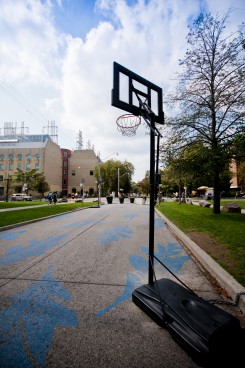Following a successful year-long pilot project, City Council has paved the way for Willcocks Street to become a permanent car-free, pedestrian-only walkway.
Approved by council on February 6, the street between Huron and St. George will be converted into a recreational area that will be used for pick-up basketball and hockey. It will also host weekly farmer’s markets and the Field to Fork Festival. Council also approved a pedestrian-only walkway at Ryerson University’s Gould Street The closure of both streets is subject to renewal every five years.
Originally a pilot that began on September 2010 at the behest of both student unions, the project was granted an extension to January 2012.
The closure was part of the Toronto Walking Strategy, which aims to create a physical and cultural environment that encourages walking. After the city conducted a survey as part of its staff report, the Toronto and East York Community Council approved the motion to keep it.
Project coordinator Alan Webb said that the main idea behind the project is to “provide round-the-clock relaxed, casual space.”
For the pilot, Webb said that the Campus and Facilities Planning Office installed “fairly modest furniture” such as basketball hoops and an astro turf patch, with umbrellas and planters being provided by the city. The street will remain as city property but the university will pay for ongoing maintenance costs.
Webb likened the long thoroughfare, something he said the university was lacking, to a European boulevard where there are “tables and chairs on the piazza sort of thing.”
“We found that it was being very well-used partly because of the location with the high concentration of students,” he said. “It provides a different type of space that’s not really associated with a college or faculty.”
Councillor Adam Vaughan, (Ward 20, Trinity-Spadina) who tabled the motion to Community Council, said the street is a great opportunity to broaden student activity and academic opportunity without causing much disruption, but added that more improvements can still be made.
“I think the street would be better if we could figure out a way to rebuild it entirely to accommodate pedestrians as opposed to simply closing it,” Vaughan said.
The curbs, according to him, may also create access issues for people in wheelchairs or with disabilities.
“I think over time, as the money becomes available, the ability to transform it into more of a plaza and less of a street is an opportunity we need to explore, but as it stands now, finding money for a project is a bit challenging,” Vaughan added.
Webb agreed, saying that a balance between accommodating both pedestrians and cyclists, who frequently use the street, must also be found.
A working group has been organized to discuss and look at long-term possibilities for the street.
The closure to the street is exciting news for students, said Shaun Shepherd, VP external for the UTSU, which advocated for more green and pedestrian-friendly space across the St. George campus.
“The next step is to see what other spaces we can transform in this way,” Shepherd said in an email response.
Vaughan said similar pedestrian-only streets are being considered in parts of Kensington Market and John Street, but did not set a time line for it.
The university also tested a pedestrian-only walkway on Devonshire Street near Bloor and Hoskin, but it was found to be problematic with disruptions to traffic and a lack of student presence.



